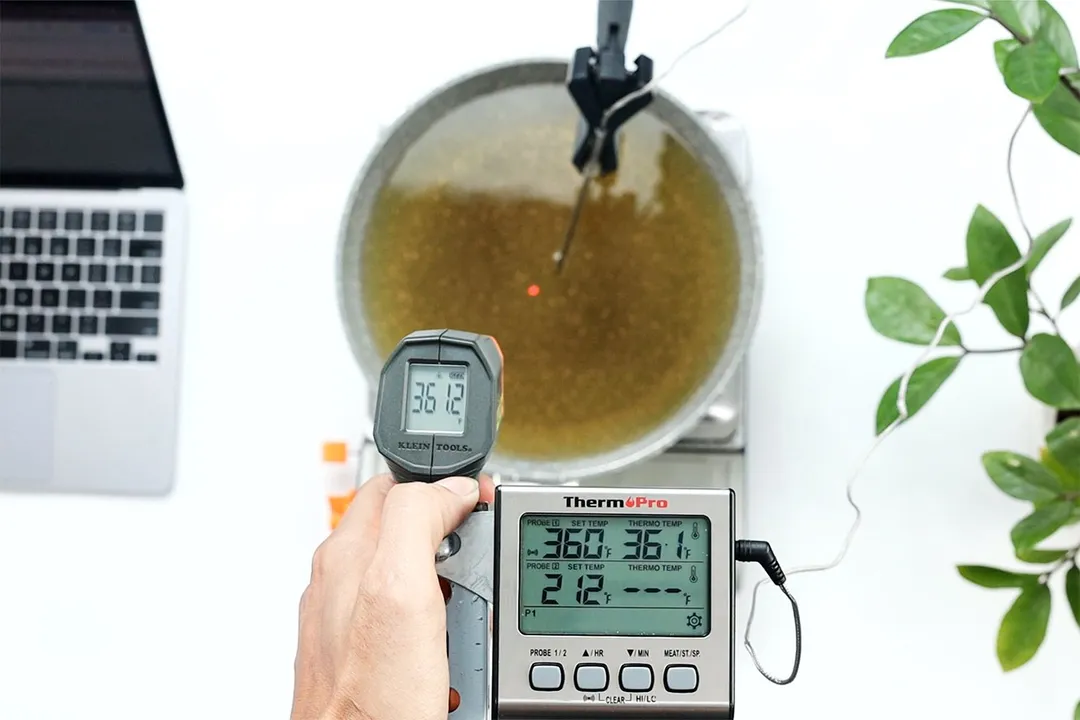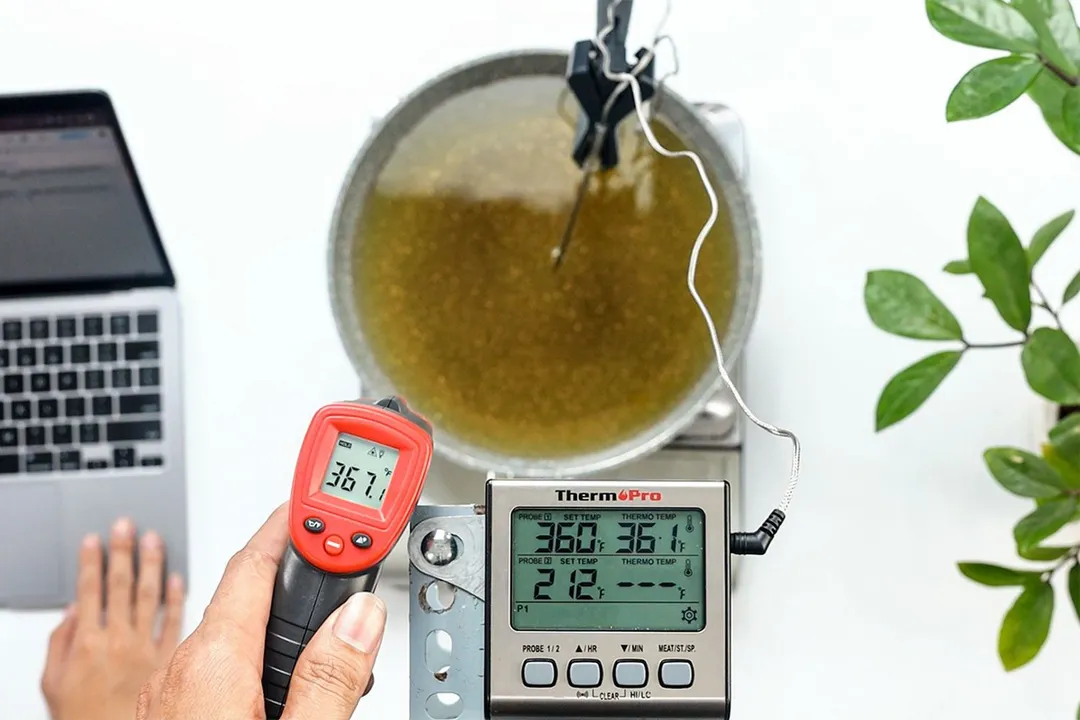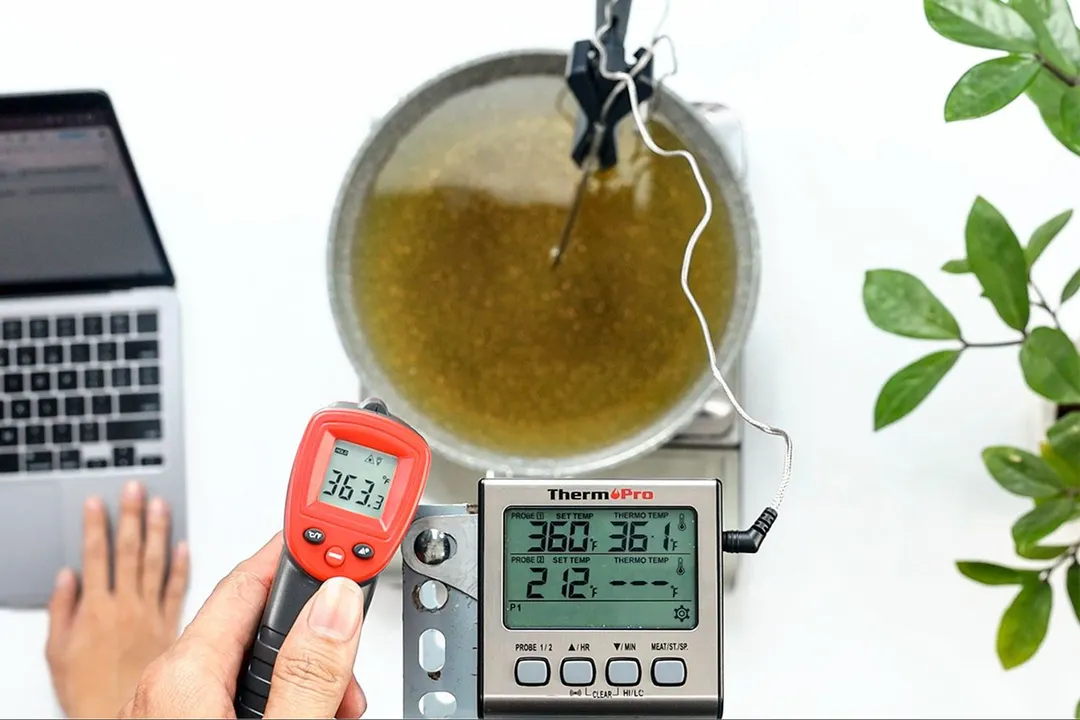Our recommendations are made independently through Research & Testing. We may receive commissions from purchases made via our links.
Cooking Oil Test for Infrared Thermometers
In the kitchen, next to a temperature probe, an IR thermometer is the next best way to measure oil temperature for cooking, which is exactly what this test is meant to represent!
This test is part of How We Test Infrared Thermometers v1.0
One of the most common applications of an IR thermometer is to measure the cooking oil temperature for frying and cooking. We replicate the exact condition for this test to determine how accurate each model is at estimating the oil temperature.
A temperature probe is used as a reference for the measurement. The closer each IR thermometer gets to the value of the temperature probe, the higher it’ll score in our test.

How We Prepare the Cooking Oil for Testing
We use vegetable oil for this test, which should have a boiling point of around 572°F (300°C). However, we don’t bring the oil to that temperature out of safety concerns. The oil only got to the typical frying temperature of around 360°F.
Vegetable oil is poured into a frying pan, then set on top of a mini stovetop. The heat is adjusted to bring the oil to 361°F (monitored by a temperature probe), then carefully reset to keep the oil temperature static.
Once the oil temperature has stabilized, that’s our signal to start the test.

How We Test IR Thermometer Using Cooking Oil
As the oil heats, we take the time to set the EMS setting for all adjustable IR thermometers to 0.94, which is the recommended emissivity setting for cooking oil.
Once the temperature has stabilized at around 361°F and the conditions have been verified by our test lead (Lap Vo), we’ll start putting each IR thermometer to the test.
Two readings are taken: one at a distance of 12 inches from the surface of the cooking oil and another at 16 inches. The distance has already been pre-measured and marked by two metal bars. We only have to brace the thermometer onto the bar and press the trigger to start the measurement.
The thermometer is put into scan mode for 3 seconds; then, the reading is taken and recorded into our database via a laptop.
During the test, the temperature of the oil can fluctuate. When that happens, we momentarily pause the test and adjust the heat until the oil temperature returns to the ideal 361°F (according to the temperature probe we use for reference.)
How We Collect, Analyze, and Score the Test Results
After the test is wrapped up and all of the data has been entered into HealthyKitchen101’s database, the team meets to finalize the results and score the performance of each IR thermometer.
For the cooking oil test, the ideal temperature reading that the thermometer should display is 361°F. If the thermometer’s reading is accurate to that of the temperature probe we use as a reference, then it would get a perfect score in this section.
The scoring of the cooking oil test takes up 60% of the total performance score.
But to make the score more accurate, the total score for this section is broken down into two sub-scores.

How We Score
We calculate the score using two major figures: the average score of each IR thermometer, and the stability variable.
Average Score
We average two readings at different distances (12 and 16 inches) to obtain the average score.
Then, we’ll compare the average to the reference temperature, which is 361°F.
The closer the average reading is to the reference temperature, the better. A match within ±2°F with the reference temperature equates to a perfect score.
For every 1°F deviation from the reference temperature, 0.5 points are taken from the average score.
Stability Variable
The distance between the thermometer and the measured object can influence the accuracy of a thermometer's reading. As such, one of our benchmarks for determining the quality of an infrared thermometer is based on whether the readings obtained at two different distances are identical across two distances.
This is what our stability variable is meant to represent. The higher the stability variable, the lower the total score will be (as it will be subtracted from the average score.)
We subtract the readings at 12 inches and 16 inches from one another to determine the mean difference.
The mean difference is further subtracted by 2 (to account for the error tolerance of the thermometers in our database, which are all around ±2°F.)
From then on, every 1°F means 0.2 points are added to the stability variable.
The formula looks like this: ([Mean Difference]-2)*0.2
There’s a caveat: the object’s surface area should be within the thermometer's D:S (Distance to Spot) ratio.
We’ve made certain before the test is run that the surface area of the oil is well within the D:S ratio of all the IR thermometers in our database. As such, this is not a concern.
Case Sample


We tested the Eventek GM550 IR thermometer by measuring temperatures at different distances.
At 12 inches away, we got a reading of 367.1°F, and at 16 inches away, we got 363.3°F.
On average, the temperature was 365.2°F, which is 4.2°F higher than the reference temperature of 361°F.
This is way more than the thermometer's supposed error tolerance of ±2°F, so we had to dock 1.1 points from its average score: (4.2-2)*0.5 = 1.1.
The average score of the Eventek, as a result, is: 10-1.1 = 8.9.
The difference is 367.1-363.3 = 5.9°F.
As such, we get the stability variable being: (5.9-2)*0.2 = 0.78.
The total score of the thermometer is 8.9-0.78 = 8.12.
Test Developers
Matthew Lee is a writer and editor for HealthyKitchen101. With over 8 years working for various outlets and agencies, specializing in tech review and other subjects of note, such as current affairs.
Lap is Head of the Research, Testing, and Review Team (RTR Team) at HealthyKitchen101.com, where he directs and supervises the testing of kitchen gadgets and appliances.
Nguyen Ntk is a graphic designer, photographer, and videographer whose philosophy centers around respecting and celebrating the beauty of reality. Through his lenses, Nguyen strives to capture the true essence of objects and events, showcasing and highlighting authentic features without distortion or exaggeration.



